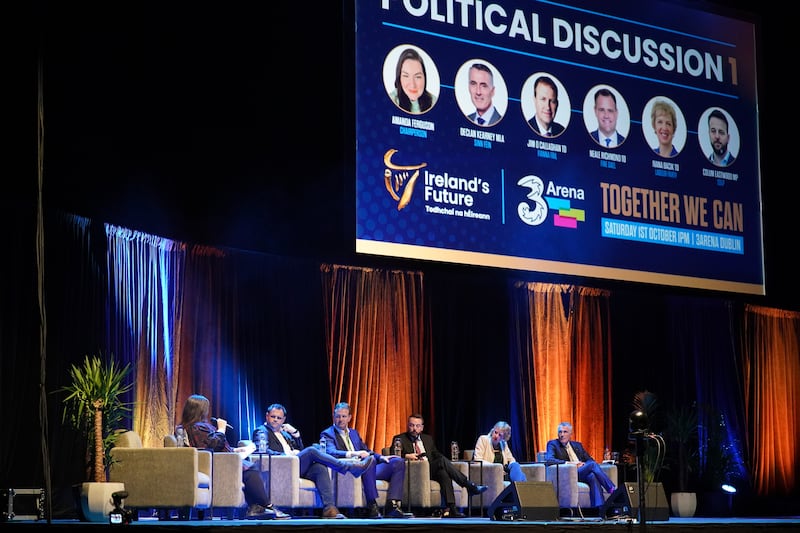The hum of debate over the prospect of reunifying the two political entities on this island grows ever louder. In the last couple of months alone, three different books have been published on the subject from a broadly nationalist perspective. And 5,000 people attended last weekend’s Ireland’s Future event in Dublin’s 3Arena, where they heard speeches from representatives of 10 political parties (unionists and the Alliance Party stayed away).
Much of this somewhat one-sided debate focuses on the logistical and constitutional implications of bringing North and South together in a single state. But there is inevitably also talk of “identities”, which are sometimes entwined with something called “culture”. There appears to be some confusion over what “culture” actually means in this context.
In his speech in the 3Arena last Saturday, Fianna Fáil’s Jim O’Callaghan posited a united Ireland in which “a loyalist flute band and the Kilfenora Céilí Band would be equally valued as expressions of the different cultural richness that exists on the island”.
Set aside for the moment the not unimportant point that, as a letter-writer to The Irish Times subsequently pointed out, only one of these musical bodies excludes people on the basis of their religion. Consider instead what this supposedly inclusive vision of parity of musical esteem omits. What if your preference is neither for Clare céilís nor Antrim marches? What if it’s for speed metal from Derry or hip-hop collectives from Limerick or for Galway string quartets? In O’Callaghan’s vision, a small number of minority pursuits are elevated to signifiers of a centuries-old cultural chasm. Given our experience of almost 25 years of sectarian whataboutery over bonfires, flags and language in post-Belfast Agreement Northern Ireland, this seems a mistake.
READ MORE
It’s a mistake for which we must blame John Hume. The great peacemaker spent decades persuading the apparently unpersuadable that the political conflict on this island was rooted not in territory or sovereignty, but in the contestation of its two traditions, Irish Catholic nationalism and British Protestant unionism. Any peace settlement would fail unless it explicitly recognised the equal rights of both. It’s Hume’s binary vision which underpinned the Belfast Agreement, the structures of government which it established, and the peace which has followed.

But that great achievement has always been flawed and incomplete. From the beginning, some bridled at the Two Traditions thesis’s failure to recognise those who chose not to align to either side and that it effectively set the sectarian divide in Northern Ireland in legal stone. That criticism has been given further impetus by the rise of the “others” on the North’s political landscape, although analysis of that phenomenon has understandably tended to emphasise its political rather than its cultural implications.
The reality is that while cultural differences have frequently been enlisted in the service of debates over political identity in Northern Ireland, culture itself – its production and consumption - has always been more fluid and less constrained by tribal boundaries than the céilí/flute band binary could ever allow. Irish republicans have been collaborating for decades with London publishers, broadcasters and producers on books, plays, films, TV dramas and documentaries. Protestant writers from Northern Ireland, musicians and performers have similarly been crossing the Border to work and live. So it shouldn’t be surprising that it was James Nesbitt, an actor from an Ulster Protestant background, who made the most subtle and thought-provoking contribution to the thousands of people in the 3Arena.
In the wake of the recent Northern Ireland census results, Fintan O’Toole argued that the rise in the number of people giving their identity as “Northern Irish” made it more likely that, post-reunification, there would be a need for “a complex set of political and cultural arrangements in which Northern Ireland continues to function as a meaningful entity”. Similarly, Leo Varadkar at last Saturday’s event held out the possibility of retaining the Northern Ireland Assembly at Stormont after reunification.
This seems perverse. If the people of Northern Ireland vote for reunification in the foreseeable future (a very big “if”), they will effectively have euthanised Carson’s six-county statelet. Any attempt to revivify the corpse is unlikely to be received with much warmth from the counties immediately north and south of the current Border. And it would be the worst possible way to ensure the civic and cultural rights of all citizens are respected in a new state.
Many other options are available, including a new, empowered system of devolved local government across the island, or a transition period with specific guarantees towards the minority previously designated as “unionist”. But in the event of a “yes” vote to unity, the Belfast Agreement and its confining vision of the multiple cultures and traditions on this island should have no more reason to survive than should Northern Ireland itself.


















